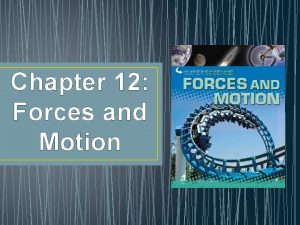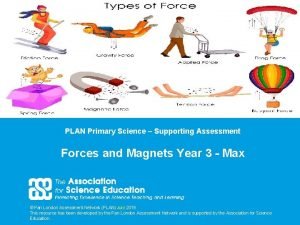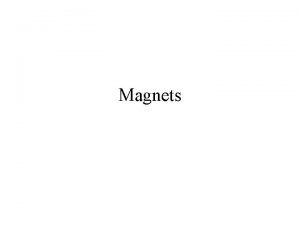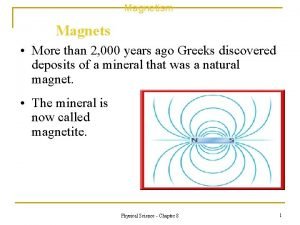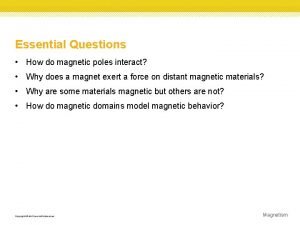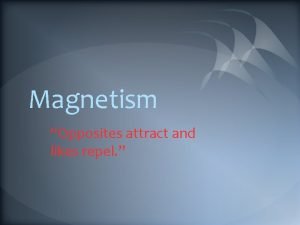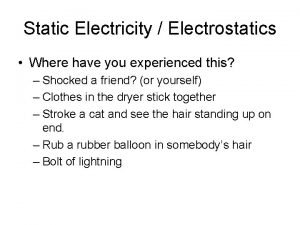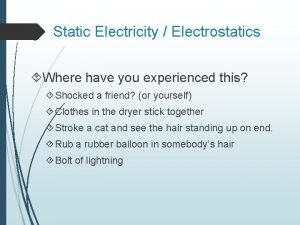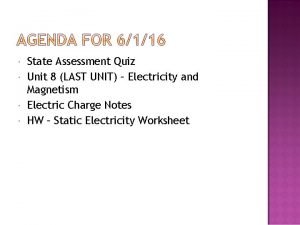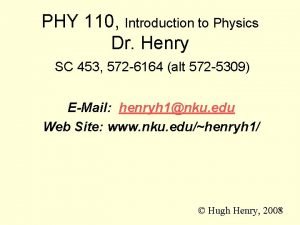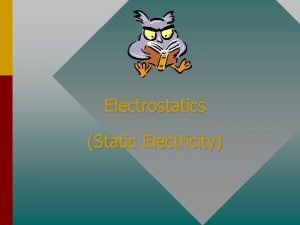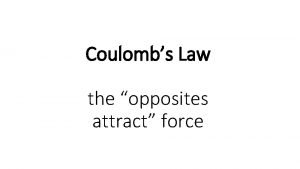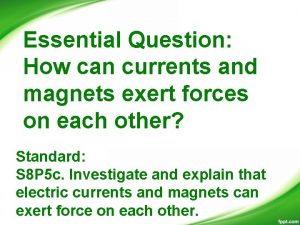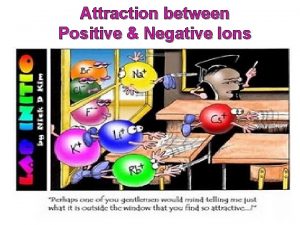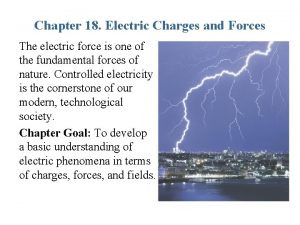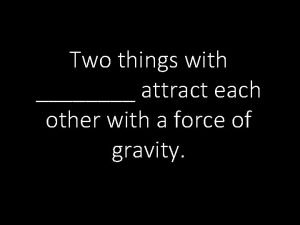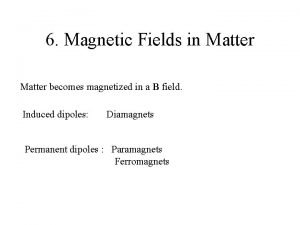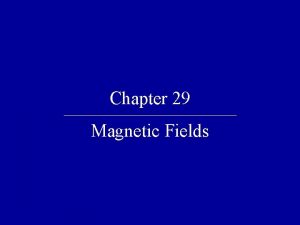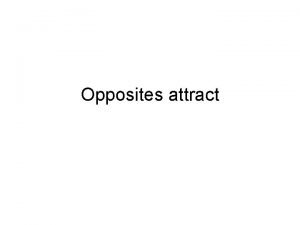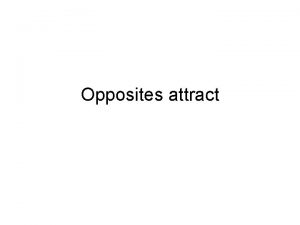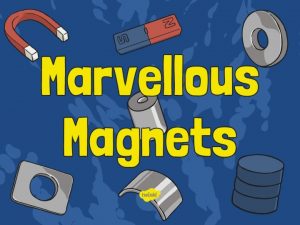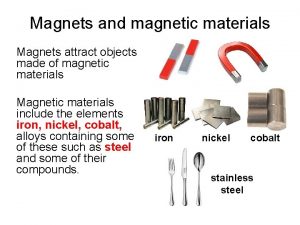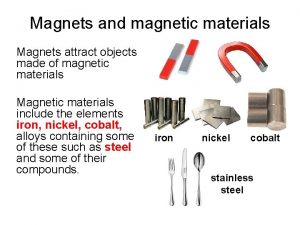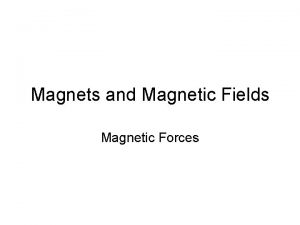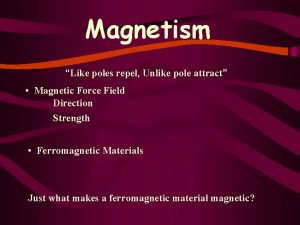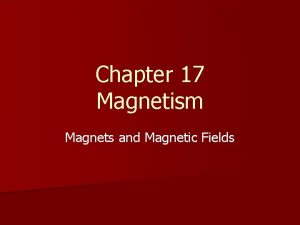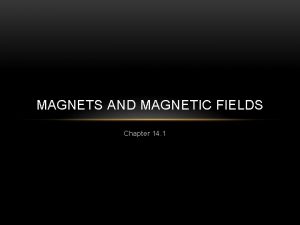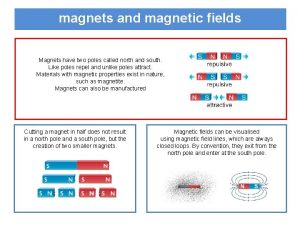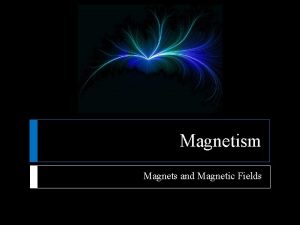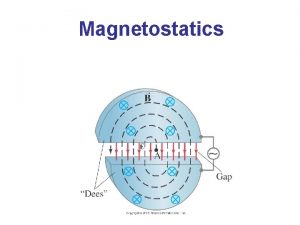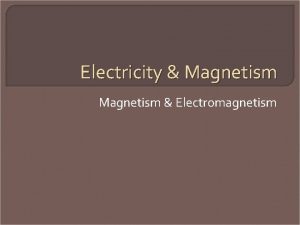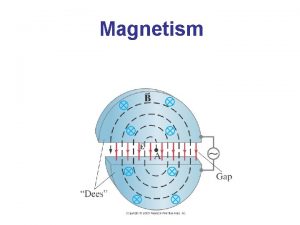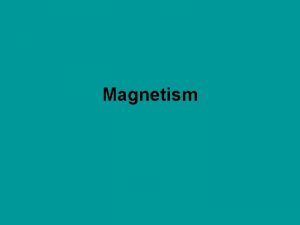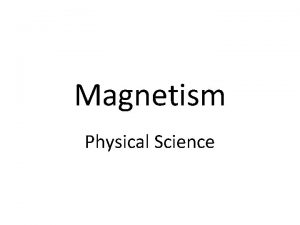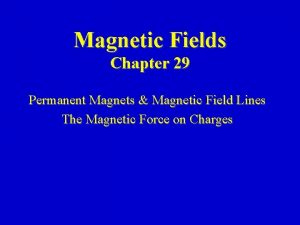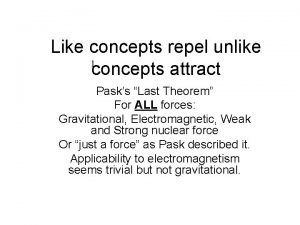Magnetic Fields Magnets can attract or repel other

























- Slides: 25

Magnetic Fields

Magnets can attract or repel other magnets. They are able to exert forces on each other without touching because they are surrounded by magnetic fields. Magnetic Flux refers to the density of the field lines. Areas with many lines have strong magnetic fields. Magnets have two different ends called poles, either north (N) or south (S).






It is important to note that magnetic fields are force fields and therefore we need to represent the lines as arrows. In fact we define the direction of a magnetic field as the direction a compass would point in that field. In a permanent magnet these lines go from north to south.

N S

We can sum up the behaviour of magnetic fields: (1) Opposites attract (2) Likes repel This is very much like electric charges; however there is a very important difference between these two. Electric charges can be singular charges (+ or -). Whereas magnetic poles always exist in pairs.

Consider a compass: A compass is useful because its needle always points north. This is because the needle is a magnet and so is the Earth. Yeah fine, but WHY does it point north? Well, the north pole of the compass will line up with the magnetic south pole of the Earth, which happens to be our geographic North Pole.



Well that’s all very well for magnetism, but where does the electro come in? It turns out that any current carrying wire is surrounded by a magnetic field. In fact a current carrying wire will have a very regular magnetic field around it as predicted by the: 1 st Right Hand Rule: Thumb: Direction of Current Fingers: Direction of Magnetic Field

Often we will represent a current carrying wire simply as though you were looking at it end on. In this case we simply draw it as a circle. To indicate the direction of current flow we draw an (X) if it is in to the page and a (·) if it is out of the page. If it helps to remember which is which think of an arrow!

Below shows current carrying wires (lines) and compasses (circles). Draw arrows to show which direction the compasses will point.


Domains: We have seen that the movement of electrons can create a magnetic field, but how does this apply to permanent magnets like bar magnets? Certain metals (iron, nickel and cobalt) have… In a piece of these metals the spins of unpaired electrons align in areas called domains. In an unmagnetized piece of metal the domains are lined up randomly. A magnet is created when these domains are aligned in one direction.


Solenoids: aka electromagnets A solenoid is simply a coil of wire. The many loops of wire each carry current and therefore their magnetic fields reinforce each other.


The 2 nd Right Hand Rule: Fingers: Direction of Current Thumb: Points towards North Note when using any right hand rules that we need to use conventional current.

Just as with a bar magnet a solenoid has a north and south pole. Note from the diagram that the field outside of a solenoid is weak and non-uniform especially if its width is much greater than its length. However the magnetic field inside the solenoid is stronger and uniform (pointing from S to N).

In a uniform magnetic field INSIDE a solenoid we can calculate the strength of the field using: Where: B = µo. In B = magnetic field strength in Teslas (T) µo = permeability of free space I = current n = # of loops per meter

Example: A hollow solenoid is 25 cm long and has 1000 loops. If the solenoid has a diameter of 4. 0 cm and a current of 9. 0 A what is the magnetic field in the solenoid?
 Magnets attract and repel
Magnets attract and repel Which diagram shows magnets that will attract each other?
Which diagram shows magnets that will attract each other? Which universal force can repel as well as attract
Which universal force can repel as well as attract Which universal force can repel as well as attract?
Which universal force can repel as well as attract? Scrap heap magnet diagram
Scrap heap magnet diagram Why do magnets repel
Why do magnets repel Why do magnets repel
Why do magnets repel Why do magnets repel
Why do magnets repel How do magnetic poles interact?
How do magnetic poles interact? Opposites attract magnets
Opposites attract magnets Electric energy
Electric energy Like charges attract or repel
Like charges attract or repel What kind of circuit is this
What kind of circuit is this Like charges attract or repel
Like charges attract or repel Like charges attract or repel
Like charges attract or repel What law states that opposites attract
What law states that opposites attract Electric bell gcse physics
Electric bell gcse physics Red fields to green fields
Red fields to green fields How do currents and magnets exert forces on each other
How do currents and magnets exert forces on each other What is the attraction between positive and negative ions
What is the attraction between positive and negative ions Particles attract each other
Particles attract each other Things that attract each other
Things that attract each other Properties of ionic compounds
Properties of ionic compounds Learning: module 26: magnetic forces and fields
Learning: module 26: magnetic forces and fields Magnetic field in matter
Magnetic field in matter Lesson quiz 29-1
Lesson quiz 29-1



